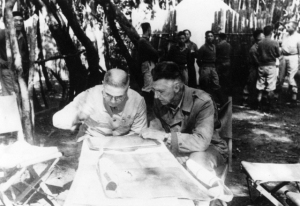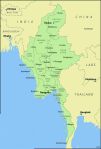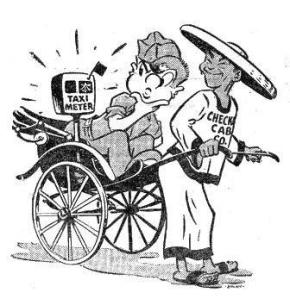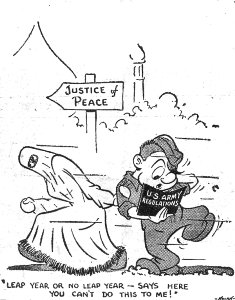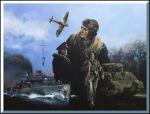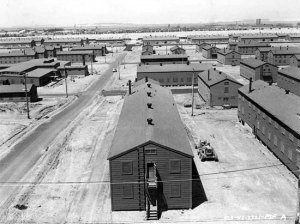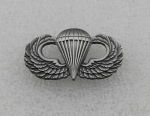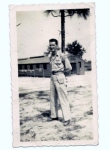Monthly Archives: August 2016
April-May 1944
During the first week of April, Gen. Stilwell’s New China Army was preparing to attack Gen. Tanaka’s men, but Stilwell’s own supply base was being threatened. Urgent pleas were sent to Chiang Kai-shek to send his Nationalist Army to eastern Burma for assistance – but Chiang failed to respond.
FDR was notified of this lack of support and the president sent a cable to Chiang: “If they [Nationalist Army] are not to be used in the common cause, our most strenuous efforts to fly in equipment and furnish instructional personnel have not been justified.”
This meant that Chiang’s Lend Lease was threatened and 10 days later, 72,000 Chinese troops marched to Burma. Japan considered this action a break in their “silent” truce and the Imperial Staff ordered the launch of the ‘Ichi-Go’ operation.
Merrill’s Marauders had incured 50% casualty losses, Merrill himself suffered a heart attack and now air bases were threatened. The Joint Chiefs of Staff approved Stilwell’s Operation End Run. Merrill signed himself out of the hospital and rallied his 1,400 survivors, 2 Chinese regiments and a band of OSS – trained guerrillas to begin a trek through the jungle and over the 6,000′ Kumon Range to reach Myitkyina. To add insult to injury (and disease), the monsoon season started early.
“The die is cast and it’s sink or swim,” Stilwell said.
At the beginning of 1944 Army Air Force units in CBI had about 1,500 airplanes, of which approximately 900 were in commission. During the critical months of March, April, and May 1944, when the Allied forces gained air superiority in Burma, American aircraft strength in India, Burma, and China ranged between 1,700 and 2,500. In 1945 the number of aircraft varied as indicated by the following table:
| 31 Jan. | 31 Mar. | 30 Apr. | 30 June | 31 July | 31 Aug. | |
|---|---|---|---|---|---|---|
| Fighters | 1,238 | 1,254 | 1,236 | 1,316 | 1,410 | 1,356 |
| Bombers (M) | 387 | 387 | 386 | 389 | 431 | 419 |
| Bombers (H) | 158 | 184 | 189 | 182 | 156 | 133 |
| Reconnaissance | 160 | 209 | 204 | 206 | 171 | 167 |
| Transports | 1,213 | 1,301 | 1,325 | 1,436 | 1,444 | 1,475 |
| Training and Liason | 536 | 540 | 538 | 513 | 487 | 485 |
| Gliders | 367 | 310 | 211 | 121 | 79 | 57 |
| TOTAL | 4,059 | 4,187 | 4,089 | 4,163 | 4,178 | 4,092 |
As these figures and those in table above emphasize, fighter and transport aircraft played the most important roles in CBI. Among fighters, the old P-40 gave way to P-38’s, P-47’s, and especially to P-51’s.
The Japanese Imperial Staff finalized the A-Go plan. And the newly organized Japanese First Mobile Fleet under VAdm. Ozawa, that was anchored at Singapore, headed for Tawi Tawi [Portal to the Philippines] under Toyoda’s orders.
Click on images to enlarge.
####################################################################################
Military Humor – from: ‘CBI Round Up’
#####################################################################################
Farewell Salutes –
Paul Bogin – Dayton, OH; US Army, Korea, Sgt., Bronze Star
Reuben Cooke – Regina, CAN; WWII, RC Army, Red Deer Army Corps/Regina Rifles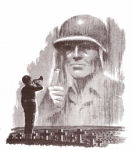
Francis Barnbrook Erikson – Fort Plain, NY; US Army Nursing Corps, WWII, ETO
Estelle Hullihan – W.Palm Bch, FL & NYC; Civilian, Radio Free Europe
Herbert Jenkins – Whangarei, NZ; NZ Expeditionary Force # 243124, WWII, 2nd Division Cavalry
Earl J. Keating – New Orleans LA; US Army, WWII, PTO, 126th/32nd Infantry Division, Pvt., KIA (Buna-Gona)
John H. Klopp – New Orleans, LA; US Army, WWII, PTO, 126th/32nd Infantry Division, Pvt. KIA (Buna-Gona)
Frank Papernic – Lynbrook, NY; US Army Air Corps, WWII, PTO, 711 Ordnance/11th Airborne Division
Thomas Tucker – Huntsville, AL; US Army, Lt.Colonel (Ret.)
Fergus Warren – Victor Harbor, AUS; RA Air Force # 071854, WWII
####################################################################################
From a Layout to a Book: Behind the Scenes at IHRA
Publishing non-fiction may not be as easy as you first imagine.
Let the IHRA historians know how you feel about their work!
Last week, we gave you an idea of how we get our information, compile it, and begin to write a compelling narrative. We left off with the chapter layout process and now we’ll finish the book. Before we get to the rest of the chapters as well as the appendices, let’s focus on the color section.
The color section consists of color photos we received, aircraft profiles, nose art closeups (this is a recent addition as of Rampage of the Roarin’ 20’s and Ken’s Men Against the Empire, Volume I), paintings, and patches. As for plane profiles, one plane from each squadron during each quarter of the war is chosen based on availability of photos, unique attributes (such as camouflage schemes and hardware), coverage of a plane, and elaborate nose art.
Once planes are chosen, we gather up all the photos and written information we have into what…
View original post 840 more words
Behind the Scenes at IHRA
This helps to explain exactly why I was so excited about the research and published volumes of the IHRA !!
From Warpath Across the Pacific to the first volume of Ken’s Men Against the Empire, our books have become the standard for World War II unit histories as well as a go-to for the history of the air war in the Pacific Theater. How did we get here? We’ll take you through part of the process of how we turn piles of photos and information into the next great installment of the Eagles Over the Pacific series.
It starts with gathering as much primary source material as possible: photos, personal diaries, letters, interviews, squadron and unit reports, medal citations, missing aircraft crew reports, and so on. Material borrowed from individual veterans was processed first, so it could be returned in a somewhat timely fashion. Before the days of scanners, photos of the photos were taken, printed out, and organized into reference binders by month. The original photos were then…
View original post 499 more words
IHRA – International Historical Research Associate’s 5th Air Force Series
I am not at all certain what I expected before my copy of Warpath Across the Pacific arrived at my doorstep, but today I find myself wholly unqualified to review IHRA’s commanding series Eagles Over the Pacific. This tome concerning the 345th Bomb Group is the highest quality of research I have ever had the pleasure to read.
Lawrence J. Hickey has created a masterpiece account of history accompanied by the artistic talent of Art Director, Jack Fellows. The Preface, written by Col. Maurice J. Eppstein, USAF Ret., delivers an impact of reality depicting life for the 498th,499th, 500th & 501st squadrons and so many others during the Pacific War.
Warpath Across the Pacific takes the readers from the establishment of the 345th, into their rigorous training and throughout their deployment. One is carried across the massive ocean to see the bases and examine each aircraft. You will eventually realize that you have come to know each crew as they prepare, experience and carry out each mission as it is described in striking detail. Then, with bated breath, you await each of their return.
The numerous maps and aircraft profiles, by Steve W. Ferguson, keep the reader orientated while being engulfed in the events, seeing their successes and feeling the pain of their losses. Countless photographs from worldwide historians and private collections are included to correspond to the information at hand. Nose-art is visible cover to cover as well as artistic illustrations of the B-25’s flown by these young, valiant men. Each airman is mentioned, the bomb squadrons profiled and the book has a special section for those killed and missing.
I find it difficult to accurately describe how greatly impressed I am by this series as each page is turned. I have never acquired a volume I value more or recommend so highly. Reading Warpath Across the Pacific was not a way to learn history, but a way to experience it!
This 5th edition even includes new material concerning the Japanese side of the war.
I thank the members of the IHRA for paying such attention to detail, for their dedication, patriotism and expertise.
Therefore, it is with the utmost confidence that I recommend these other editions of the series…
# 2 – Revenge of the Red Raiders –
An equal effort of historical importance concerning the 22nd Bombardment Group/5th Air Force. The same attention to detail as they bring the reader from the airfields of America to the SW Pacific skies.
# 3 – Rampage of the Roarin’ 20’s –
The life and wartime of the 312th Bombardment Group/5th Air Force follows in the same style and professional manner. Read and imagine these young men in their P-40 Warhawks and later, the Douglas A-20 Havoc aircraft.
# 4 – Ken’s Men Against the Empire – Vol. 1 –
This project by the IHRA, contains the history of the 43rd Bombardment Group, generated such an abundance of material that it was necessary to create two volumes rather than omit any information. With the early war and the B-17 era, and then re-equipping with B-24’s for this young, but growing unit.
This edition holds the detailed and accurate missions of the most highly decorated crew in U.S. history, Zeamer’s “Eager Beavers.” You can start your journey with these squadrons as they progress through the Pacific and witness it as never before. Should you have any doubt about their research from U.S. training bases – through New Guinea, the Netherlands Indies, the Philippines, Indochina and Japan – a reblog 0f their own post will show, (rather than tell), you how expertly each record is handled.
As Lawrence Hickey stated in his Introduction: “This, then, is the story of the ‘Air Apaches.'”
To locate the IHRA blog – Please Click Here!
To purchase any volume from the IHRA, click HERE!
Click on images to enlarge.
###################################################################################
Farewell Salutes –
William Cather – Birmingham, AL; US Army Air Corps, WWII, PTO, 501st “Black Panthers”/345th, Capt.
Glenn Doolittle – San Antonio, TX; US Army Air Corps, WWII, PTO, 435th Bombardment Group, Silver Star, Col.
Lester Gurden – Owosso, MI; US Army Air Corps, WWII, PTO, SSgt., radio technician
William Hammock – Columbus, OH; US Army Air Corps, WWII
Bruce Hanson – Nampa, IA; US Army Air Corps, WWII, PTO, B-25 pilot
Erwin Johnson – New Orleans, LA; US Army Air Corps, WWII, 27th Bomb Group, A-20 air mechanic, POW
Gerald Levin – Baltimore, MD; US Army Air Corps, WWII, PTO
William Michels – Alexandria, VA; US Army Air Corps, WWII, Engineer Corps
Louis Mori – Ronoke Rapid, NC; US Army Air Corps, WWII, PTO, 674th Artillery/11th Airborne Division
Harold Peterson – Boston, MA; US Army Air Corps, WWII, ETO, radioman
####################################################################################https://pacificparatrooper.files.wordpress.com/2016/08/rrr-cover.jpg
Smitty, April/May 1944 & Letter II
Letter II Thursday 5/4/44
Dear Mom,
There really isn’t much to write about as I’ve told you most everything on the phone. By the way, when you receive your bill for the month let me know just how much these calls cost.
I heard from Harley yesterday and it seems that he wants something to do and they just won’t give him anything. They have now made him landscape sergeant and I can just see him pulling weeds and taking care of flowers. If he should ever get his load on, he’ll nip out the flowers and let the weeds alone. I haven’t written to Woods yet, but give me time. I’ll get around to it before long.
We have to police up the area now, so will leave you for a while. Be back before long. — Hello again. We no sooner pick up the old cigarette butts and paper than some jerk behind you drops one so that cleaning up is getting to be a problem. Policing up is what is known as body bending exercise, head down, backsides pointing to the sky.
Well mom, that is all there is for now so take care of yourself and give my regards to all.
All my love, Everett
Smitty was unable to tell his mother that he and the 11th A/B would be shipping out the following day – destination and mission unknown. The men cruised from Suisan Bay into San Pablo Bay, into San Francisco Bay and under the Oakland Bridge to Oakland Mole where the Red Cross passed out coffee and donuts while they boarded the transport ships. So … back under the Oakland Bridge, thru San Francisco Bay and under the Golden Gate Bridge to the open Pacific.
Camp Stoneman & Letters I & II | Pacific Paratrooper//
This photograph on the left was removed from a New York newspaper. The sign above the entry states: “Through these portals pass the best damn soldiers in the World.” The clipping beside it indicates shipping out dates. The 11th A/B departed May 5, 1944. Smitty said that this cruise would be the most boring part of his service, although he did become quite adept at playing cards during this time.
####################################################################################
Military Humor –
####################################################################################
Farewell Salutes –
Hideo Abe – San Jose, CA; US Army, WWII, PTO, Nisei MISer
Anton Beck – Saskatoon, CAN; RC Air Force, WWII, ETO, 422nd Squadron, aero engine mechanic
William Donaldson – Hagerstown, MD; US Navy, WWII, PTO
John Farkas – Bridgeport, CT; US Army, WWII, ETO
Marge Gibbs – Pittsboro, IN; US Navy WAVE, WWII
Wilford Green – East Meadow NY; US Merchant Marine
George Hamann – Milwaukee, WI; US Navy, WWII, PTO, USS Enterprise
Bill Lively – Ruidoso, NM; US Army Air Corps, WWII, PTO, G/187th/11th Airborne Division
Michael McFall – Ft. Lauderdale, FL; US Marine Corps
Edward Simms – Stanaford, WV; US Navy, Korea, USS Wasp
#####################################################################################
Smitty, April 1944 & Letter I
Pvt. Smith was as cocky and proud as the next trooper, but he also thought of the army as a learning experience and considered his new adventure as a chance to experience things he would not otherwise have the opportunity. On April 23, 1944, he stepped off a train near Camp Stoneman, California. Here the troopers would learn how to live aboard ship, operate life boats, raft kits and climb up and down rope ladders. Censorship of the soldier’s letters began here. The Inspector General’s men discovered the ruse of the 11th A/B Division hiding behind the paperwork of Shipment #1855 and the troopers began to accumulate AW104’s in record amounts. (Under the Article of War #104 – a commanding officer may give punishment, as is necessary, without the threat of court-martial.) May 2, the 11th A/B moved to Pittsburg, CA by way of inland boats to their actual POE and the letters from Smitty began …
Letter I Tuesday 5/2/44
Dear Mom,
I sure am a fine one after calling you Sunday especially to wish you a Happy Birthday and I go and forget to, but I assure you it wasn’t intentional, but just excitement of the conversation. I tried yesterday to buy a card, but to no avail. No doubt by the time you receive this letter you will be wondering why I didn’t call you this week as I promised I would. It just so happened that we were confined to our company area starting yesterday morning, so it was an impossibility to get to either a telephone or telegraph office.
From now on all my letters to you will be numbered as this one is in the upper left hand corner. In that way, you can read my letters in sequence and can tell whether or not you are receiving all my letters. I would also advise sending all letters to me from now on by airmail as that will be the quickest way. We heard that not all the mail so far from here has yet been sent out, but when it does go out, why you will no doubt get them all at once. Tell everyone at home to be patient and they will no doubt hear from me as I sit down Saturday and either write a letter or card to everyone I know. You had better check up on them all and see that they have my correct address, as the army will notify only you of any new changes. I sure don’t want to lose out on my letters of anyone just because they have an incorrect address.
Yesterday we didn’t do much of anything, but Sunday was really quite an entertaining day. We went bowling, then to a free USO show and from there to a movie. The entertainment is so full and alive that sometimes it still persists in your dreams. Therefore, you can really say they even take care of you while you are slumbering. Well mom, that is all for now, so once more I want to wish you a “Happy Birthday” and the best of everything. Don’t worry and keep your chin up.
Love,
Everett
PS – Be on the lookout for a new Class E allotment I made out and also a B allotment. Your allotments now will come to 22 dollars cash and a $18.75 war bond a month. I’m getting pretty good, aren’t I?
Click on images to enlarge.
###################################################################################
Military Humor –
#####################################################################################
Farewell Salutes –
Joseph Bernardo – Norwich,CT; US Army Air Corps, WWII, PTO, 188th Reg/11th Airborne Division
Andrew Gettings – NYC, NY; US Army Air Corps, WWII
Robert Guinan – Watertown, NY; US Air Force, Korea
David Lamphere – St. Cloud, MN; US Army Air Corps, WWII, PTO, 511/11th Airborne Division
Milton Moss – Lebabon, OR; US Army Air Corps, WWII, PTO, 221st Med/11th Airborne Division
Robert Neavear – Siloam Springs, AR; US Army Air Corps, WWII, PTO, 503/11th Airborne Division
Bernard Neihm – Gallipolis OH; US Army Air Corps, WWII, PTO, 457 Artillery/11th Airborne Div,
James Parcell Sr. – Wooster, OH; US Army, 101st Airborne Division
Cecil Robson – Casa, AZ; US Army Air Corps, WWII, PTO, 675 Artillery/11th Airborne Division
Albert Scigulinsky – Perth Amboy, NJ; US Army Air Corps, WWII, PTO, 11th Airborne Division
#####################################################################################
U.S. Airborne Day, 16 August
“Airborne All the Way”
Author unknown
These men with silver wings
Troopers from the sky above
In whom devotion springs
What spirit so unites them?
In brotherhood they say
Their answer loud and clear.
“Airborne All the Way.”
These are the men of danger
As in open door they stand
With static line above them
And ripcord in their hand.
While earthbound they are falling
A silent prayer they say
“Lord be with us forever,
Airborne All the Way.”
One day they’ll make their final jump
Saint Mike will tap them out
The good Lord will be waiting
He knows what they’re about
And answering in unison
He’ll hear the troopers say
“We’re glad to be aboard, Sir,
Airborne All the Way!”
For another outstanding poem in honor of the U.S. Army Airborne – Please visit, Lee at ……
Click on images to enlarge.
#####################################################################################
Army Air Corps Humor – 
#####################################################################################
Farewell Salutes –
Earl Aardappel – Harrison, NE; US Army Air Corps, WWII, CBI (The Hump), 11th Combat Cargo Sq/14th AF
Harold Bell – Las Vegas, NV; US Army Air Corps, WWII, bombardier/navigator
Dick Dennigan – St. Paul, MN; US Army Air Corps, WWII, Flight officer
David Groner – Bronx, NY; US Army Air Corps, WWII, CBI, C-46 Crew Chief, Bronze Star
Bertha Hespe – Fairview, NJ; US Army Women’s Air Corps (WAC), WWII, aircraft mechanic
Keith Kendall – LeMars, IA; US Army Air Corps, WWII, physical training instructor
Gerald Levin – Baltimore, MD; US Army Air Corps, WWII, PTO
Harold Peterson – Newton, MA; US Army Air Corps, WWII, ETO, radioman
James Short – Isabel, KS; US Army Air Corps, WWII, ETO, B-17 pilot
George Walling – Chicago, IL; US Army Air Corps, WWII, PTO, B-17 radar
#####################################################################################
Navajo Code Talkers Day
During WWI, the Choctaw language had been used to transmit U.S. military messages. With this thought in mind, Philip Johnston, the son of a missionary grew up on a Navajo reservation and spoke the Diné tongue fluently, brought the suggestion of a similar code to General Clayton Vogel early in 1942. The Diné language has no alphabet, uses no symbols and one sound may hold an entire concept. The idea was tested and proved to be faster and more reliable than the mechanized methods. The language has more verbs than nouns, that helps to move the sentences along and makes it far more difficult for outsiders to learn – making it the most ingenious and successful code in military history.
The original class, the 382d Platoon, Navajo Communication Specialists, USMC, developed their code at Camp Pendleton. Once a unit of code talkers were trained, they were put on Marine rosters around the Pacific Theater. Even under severe combat conditions, they remained the living codes, since nothing was ever written down. During the first 48 hours of Iwo Jima, 800 transmissions were coded. These few men became warriors in their own right during some of the worst battles of the war.
Some examples of the English word/ Navajo sound/ literal translation:
Alaska………. Beh-hga……….. with winter
America……….Ne-he-mah……… our mother
Britain……….Toh-ta………… between waters
Australia……..Cha-yes-desi…….rolled hat
China…………Ceh-yehs-besi……braided hair
France………..Da-gha-hi……….beard
The existence of the code talkers and their accomplishments would remain top secret according to the U.S. government and use their expertise in the Korean War. Unfortunately, this resulted in many of the men not receiving the recognition they deserved. I was very lucky to have grown up knowing their story thanks to Smitty, my father.
President Ronald Reagan designated 14 August as National Code Talkers Day in 1982.
Click on images to enlarge.
#########################################################################################################################
Farewell Salutes –
Rocco Addeo Sr. – Brooklyn, NY; US Navy, WWII, 7th Fleet
Daniel Bolinski – Shamokin, PA; US Army Air Corps, WWII, Korea/POW
Philip Cooke – Brisbane, AUS; RA Air Force & RAF, WWII
Edward Flora – South Bend, IN; US Army Air Corps, WWII, PTO, 11th Airborne Division
John Guardino Sr. – Boca Raton, FL; USMC, Korea
Delbert Latta – Bowling Green, OH; US Army/USMC, WWII, (US Congressman)
Charles McCaughan – Darfield, NZ; RNZ Army # 40553, WWII
Merle Sargent – Springville, UT; US Army, WWII, PTO
James Sinclair – Bosman, CAN; RC Army, WWII, ETO, 17th Firld Reg/Royal Reg. of Canadian Artillery
Donald Weaver – Wayne City, IL; US Navy, WWII, PTO
####################################################################################
B-25 Bomber Virtual Tour
An eye witness account from John Poltrack for his Uncle Ed that not many have seen!
North American B-25 Mitchell: The Ultimate Look: From Drawing Board to Flying Arsenal
My Uncle Ed Poltrack piloted 60 missions in the Pacific Theatre in WWII. He piloted a B-25 Mitchell Bomber. The National Museum of the Air Force website has an interactive photo gallery of the interior of this aircraft (see the links under the photo). Note:Ed piloted a variation of the original design in which the transparent nose was replaced with two fixed machine guns.
 38th Bomb Group – 823rd Squadron
38th Bomb Group – 823rd Squadron
Click on links to see a 360 degree view of the interior of this aircraft (links open in new window)
Pilot Station
Bombadier
Radio Operator
Tail Gunner
 Ed Poltrack in Cockpit
Ed Poltrack in Cockpit
From Ed Poltrack’s War Diary — Sunday, April 15, 1944 – Mission #48
Mission to Hollandia. Nil interception. Nil ack-ack. On return met a solid front near Bogadjim. Turned toward coast and found a hole on…
View original post 181 more words
April 1944 (2)

Battle of Kohima
4 April – In the CBI, the Japanese started their offensive towards India by attacking Kohima, India. This operation would suffer from supply problems and the typhoon season. Over 30,000 of the enemy would eventually be lost to due to disease and starvation. Ground troops in Burma received support from the 10th Air Force as over 120 aircraft struck Japanese railroads and supply areas.
5-6 April – the Japanese 138th, 58th and 24th regiments of the 31st Div. surrounded the Allied troops at Kohima into a 10-mile pocket. The 58th attempted to make a surprise attack at the center, but were thwarted by the Royal West Kents. Within the circle, dependent on air supply were the 17th Indian Light Div., 50th Parachute Brigade, 5th Indian Div, 23rd Indian Div. and the 254th Tank Brigade.

10th Gurkha Rifles clearing ‘Scraggy Hill’ at Imphal
6-18 April – the Japanese 53rd in Burma took the Chindit supply base known as “White City.” The Chindits in northern Burma received glider-borne reinforcements. They then occupied the Japanese base at Indau and that cut the enemy off from southern Burma.
7 April – in Japan, it was decided that despite the Army being overstretched in the Pacific and Burma, the new offensive in China would commence. Inchi-Go’s objective was to occupy south China, thereby providing open land routes to their other forces in Malaya and Thailand while crushing US air bases.
7-13 April – in India, the Japanese 138th Regiment encircled the 161st Indian Brigade and took Kohima, but further into the settlement, 1500 troops [mostly the Assam Rifles and 4th Royal West Kents), best back the invaders.
14-18 April – the Allied XXXIII Corps began to try relief operations in the Kohima area. The 5th Brigade/2nd Div. smashed the Japanese roadblock at Zubza and made a break in the circle around the 161st Indian Division.
18 April – the Allied troops were finally relieved in the Kohima area as the 5th Brigade reached them. This does not in any way slow the fighting down. Both sides tried to encircle the other with flanking maneuvers.

Kohima War Cemetery
26-27 April – the Allied XXXIII Corps started a major offensive to retake Kohima. The 5th attacked the Japanese right flank from the north and the 4th Brigade came from the south. After the British took the road junction, both sides took entrenched positions about 72 feet apart, around the “Tennis Court”. The following 2 weeks would bring heavy and close-quarter battles.
27-28 April – in New Guinea, the Cyclops Airdrome had limited operation. With the swift success at Hollandia, plans by generals MacArthur and Kenney began to take form on heading west.
A short gallery of photos of constructing an airdrome in WWII.
Click on images to enlarge.
####################################################################################
CBI Military Humor –
####################################################################################
Farewell Salutes –
Eddie Agurkis – Newburgh, NY; USMC, WWII & Korea
Simon Bromley – AUS; RA Air Force
Ethel Gay Carmichael – Leader, CAN; RC Air Force (WD), WWII
Edward Ebanks – Hollywood, FL; Merchant Marine (Ret. 45 years)
Paul Kelly Sr. – Brighton, MA; US Army Air Corps, WWII, B-17 pilot “Millie K”
John McCambridge – Broad Channel, NY; US Army, WWII
Samuel Prather – Seattle, WA; US Army Air Corps, WWII, PTO, 1st Lt.
Andrew Repasky – Library, PA; US Army Air Corps, WWII, PTO, 11th Airborne, artillery
Robert Segil – Salt Lake City, UT; US Army, WWII, PTO, Lt., tank destroyer unit
Ruth Turner – Knoxville, TN; US Cadet Nursing Corps, WWII
#####################################################################################
